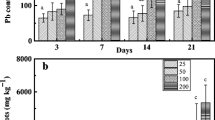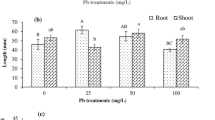Abstract
We used hydroponic experiments to examine the effects of different concentrations of lead (Pb) on the performance of the Pb-tolerable plant Conyza canadensis. In these experiments, most of the Pb was accumulated in the roots; there was very little Pb accumulated in stems and leaves. C. canadensis is able to take up significant amounts of Pb whilst greatly restricting its transportation to specific parts of the aboveground biomass. High Pb concentrations inhibited plant growth, increased membrane permeability, elevated antioxidant enzyme activity in roots, and caused a significant increase in root H2O2 and malondialdehyde content. Analysis of Pb content at the subcellular level showed that most Pb was associated with the cell wall fraction, followed by the nucleus-rich fraction, and with a minority present in the mitochondrial and soluble fractions. Furthermore, transmission electron microscopy and energy dispersive X-ray analysis of root cells revealed that the cell wall and intercellular space in C. canadensis roots are the main locations of Pb accumulation. Additionally, high Pb concentrations adversely affected the cellular structure of C. canadensis roots. The increased enzyme activity suggests that the antioxidant system may play an important role in eliminating or alleviating Pb toxicity in C. canadensis roots. However, the levels of non-protein sulfhydryl compounds, glutathione, and phytochelatin did not significantly change in either the roots or leaves under Pb-contaminated treatments. Our results provide strong evidence that cell walls restrict Pb uptake into the root and act as an important barrier protecting root cells, while demonstrating that antioxidant enzyme levels are correlated with Pb exposure. These findings demonstrate the roles played by these detoxification mechanisms in supporting Pb tolerance in C. canadensis.










Similar content being viewed by others
References
Aebi H (1984) Methods in enzymology. Elsevier, London, pp 121–126
Andersen HR, Nielsen JB, Nielsen F, Grandjean P (1997) Antioxidative enzyme activities in human erythrocytes. Clin Chem 43:562–568
Arshad M, Silvestre J, Pinelli E, Kallerhoff J, Kaemmerer M, Tarigo A, Shahid M, Guiresse M, Pradère P, Dumat C (2008) A field study of lead phytoextraction by various scented Pelargonium cultivars. Chemosphere 71:2187–2192
Basile A, Giordano S, Cafiero G, Spagnuolo V, Castaldo-Cobianchi R (1994) Tissue and cell localization of experimentally-supplied lead in Funaria hygrometrica Hedw. using X-ray SEM and TEM microanalysis. J Bryol 18:69–81
Bibi M, Hussain M (2005) Effect of copper and lead on photosynthesis and plant pigments in black gram [Vigna mungo (L.) Hepper]. B Environ Contam Tox 74:1126–1133
Cheng H, Hu Y (2010) Lead (Pb) isotopic fingerprinting and its applications in lead pollution studies in China: a review. Environ Pollut 158:1134–1146
De Vos CR, Vonk MJ, Vooijs R, Schat H (1992) Glutathione depletion due to copper-induced phytochelatin synthesis causes oxidative stress in Silene cucubalus. Plant Physiol 98:853–858
Ebbs S, Lau I, Ahner B, Kochian L (2002) Phytochelatin synthesis is not responsible for Cd tolerance in the Zn/Cd hyperaccumulator Thlaspi caerulescens (J. & C. Presl). Planta 214:635–640
Fu X, Dou C, Chen Y, Chen X, Shi J, Yu M, Xu J (2011) Subcellular distribution and chemical forms of cadmium in Phytolacca americana L. J Hazard Mater 186:103–107
Ghaedi M, Ahmadi F, Shokrollahi A (2007) Simultaneous preconcentration and determination of copper, nickel, cobalt and lead ions content by flame atomic absorption spectrometry. J Hazard Mater 142:272–278
Gupta DK, Nicoloso FT, Schetinger M, Rossato LV, Pereira LB, Castro GY, Srivastava S, Tripathi RD (2009) Antioxidant defense mechanism in hydroponically grown Zea mays seedlings under moderate lead stress. J Hazard Mater 172:479–484
Gupta DK, Huang HG, Yang XE, Razafindrabe BHN, Inouhe M (2010) The detoxification of lead in Sedum alfredii H. is not related to phytochelatins but the glutathione. J Hazard Mater 177:437–444
Huang JW, Chen J, Berti WR, Cunningham SD (1997) Phytoremediation of lead-contaminated soils: role of synthetic chelates in lead phytoextraction. Environ Sci Technol 31:800–805
Huang H, Gupta DK, Tian S, Yang X, Li T (2012) Lead tolerance and physiological adaptation mechanism in roots of accumulating and non-accumulating ecotypes of Sedum alfredii. Environ Sci Pollut R 19:1640–1651
Islam E, Liu D, Li T, Yang X, Jin X, Mahmood Q, Tian S, Li J (2008) Effect of Pb toxicity on leaf growth, physiology and ultrastructure in the two ecotypes of Elsholtzia argyi. J Hazard Mater 154:914–926
Kastori R, Plesničar M, Sakač Z, Panković D, Arsenijević Maksimović I (1998) Effect of excess lead on sunflower growth and photosynthesis. J Plant Nutr 21:75–85
Kopittke PM, Asher CJ, Blamey FPC, Auchterlonie GJ, Guo YN, Menzies NW (2008) Localization and chemical speciation of Pb in roots of signal grass (Brachiaria decumbens) and Rhodes grass (Chloris gayana). Environ Sci Technol 42:4595–4599
Kosobrukhov A, Knyazeva I, Mudrik V (2004) Plantago major plants responses to increase content of lead in soil: growth and photosynthesis. Plant Growth Regul 42:145–151
Kumar A, Prasad M, Sytar O (2012) Lead toxicity, defense strategies and associated indicative biomarkers in Talinum triangulare grown hydroponically. Chemosphere 89:1056–1065
Li X, Zhang L, Li Y, Ma L, Bu N, Ma C (2012) Changes in photosynthesis, antioxidant enzymes and lipid peroxidation in soybean seedlings exposed to UV-B radiation and/or Cd. Plant Soil 352:377–387
Lichtenthaler HK, Buschmann C (2001) Chlorophylls and carotenoids: measurement and characterization by UV–VIS spectroscopy. Current protocols in food analytical chemistry. Rev Environ Contam T 26:11–17
Liu J, Mei C, Cai H, Wang M (2015) Relationships between subcellular distribution and translocation and grain accumulation of Pb in different rice cultivars. Water Air Soil Poll 226:1–9
Lutts S, Kinet JM, Bouharmont J (1996) NaCl-induced senescence in leaves of rice (Oryza sativa L.) cultivars differing in salinity resistance. Ann Bot 78:389–398
Małecka A, Piechalak A, Morkunas I, Tomaszewska B (2008) Accumulation of lead in root cells of Pisum sativum. Acta Physiol Plant 30:629–637
Meyers DE, Auchterlonie GJ, Webb RI, Wood B (2008) Uptake and localisation of lead in the root system of Brassica juncea. Environ Pollut 153:323–332
Mingorance MD, Leidi EO, Valdés B, Oliva SR (2012) Evaluation of lead toxicity in Erica andevalensis as an alternative species for revegetation of contaminated soils. Int J Phytoremediat 14:174–185
Mishra S, Srivastava S, Tripathi RD, Kumar R, Seth CS, Gupta DK (2006) Lead detoxification by coontail (Ceratophyllum demersum L.) involves induction of phytochelatins and antioxidant system in response to its accumulation. Chemosphere 65:1027–1039
Nishizono H, Ichikawa H, Suziki S, Ishii F (1987) The role of the root cell wall in the heavy metal tolerance of Athyrium yokoscense. Plant Soil 101:15–20
Patra J, Lenka M, Panda BB (1994) Tolerance and co-tolerance of the grass Chloris barbata Sw. to mercury, cadmium and zinc. New Phytol 128:165–171
Pawlik-Skowrońska B (2002) Correlations between toxic Pb effects and production of Pb-induced thiol peptides in the microalga Stichococcus bacillaris. Environ Pollut 119:119–127
Pourrut B, Shahid M, Dumat C, Winterton P, Pinelli E (2011) Lead uptake, toxicity, and detoxification in plants. Rev Environ Contam 213:113–136 (Springer)
Qiao X, Zheng Z, Zhang L, Wang J, Shi G, Xu X (2015) Lead tolerance mechanism in sterilized seedlings of Potamogeton crispus L.: subcellular distribution, polyamines and proline. Chemosphere 120:179–187
Salazar MJ, Pignata ML (2014) Lead accumulation in plants grown in polluted soils. Screening of native species for phytoremediation. J Geochem Explor 137:29–36
Shahid M, Pinelli E, Pourrut B, Silvestre J, Dumat C (2011) Lead-induced genotoxicity to Vicia faba L. roots in relation with metal cell uptake and initial speciation. Ecotoxicol Environ Safe 74:78–84
Sharma P, Dubey RS (2005) Lead toxicity in plants. B J Plant Physiol 17:35–52
Sytar O, Kumar A, Latowski D, Kuczynska P, Strzałka K, Prasad M (2013) Heavy metal-induced oxidative damage, defense reactions, and detoxification mechanisms in plants. Acta Physiol Plant 35:985–999
Tamura H, Honda M, Sato T, Kamachi H (2005) Pb hyperaccumulation and tolerance in common buckwheat (Fagopyrum esculentum Moench). J Plant Res 118:355–359
Tian S, Lu L, Yang X, Webb SM, Du Y, Brown PH (2010) Spatial imaging and speciation of lead in the accumulator plant Sedum alfredii by microscopically focused synchrotron X-ray investigation. Environ Sci Technol 44:5920–5926
Tian S, Lu L, Yang X, Huang H, Brown P, Labavitch J, He Z (2011) The impact of EDTA on lead distribution and speciation in the accumulator Sedum alfredii by synchrotron X-ray investigation. Environ Pollut. 159:782–788
Verma S, Dubey RS (2003) Lead toxicity induces lipid peroxidation and alters the activities of antioxidant enzymes in growing rice plants. Plant Sci 164:645–655
Wang S, Zhang J (2006) Blood lead levels in children, China. Environ Res 101:412–418
Wang X, Liu Y, Zeng G, Chai L, Song X, Min Z, Xiao X (2008) Subcellular distribution and chemical forms of cadmium in Bechmeria nivea (L.) Gaud. Environ Exp Bot 62:389–395
Wu Z, McGrouther K, Chen D, Wu W, Wang H (2013) Subcellular distribution of metals within Brassica chinensis L. in response to elevated lead and chromium stress. J Agr Food Chem 61:4715–4722
Zhou XY, Qiu RL, Li QF, Shi N, Zhang T, Hu PJ, Ying RR (2008) Effects of zinc on distribution and chemical form of lead in Potentilla griffithii var. velutina. Acta Sci Circumstantiae 28:2064–2071
Zhou CF, Wang YJ, Sun RJ, Liu C, Fan GP, Qin WX, Li CC, Zhou DM (2014) Inhibition effect of glyphosate on the acute and subacute toxicity of cadmium to earthworm Eisenia fetida. Environ Toxicol Chem 33:2351–2357
Zhou CF, Zhang K, Lin JW, Li Y, Chen NL, Zou XH, Hou XL, Ma XQ (2015) Physiological responses and tolerance mechanisms to cadmium in Conyza canadensis. Int J Phytoremediation 17:280–289
Acknowledgments
This work was supported by Research project of forestry public welfare industry of the State Forestry Bureau of China (201304303), Foundation for Cultivation plan of Distinguished Young Scholars of Fujian Province, National Natural Science Foundation of China (31400465, 41401364), and Major projects of agricultural science and technology cooperation in Agricultural University (2013N5002).
Author information
Authors and Affiliations
Corresponding author
Additional information
Ying Li and Chuifan Zhou contributed equally to this study.
Rights and permissions
About this article
Cite this article
Li, Y., Zhou, C., Huang, M. et al. Lead tolerance mechanism in Conyza canadensis: subcellular distribution, ultrastructure, antioxidative defense system, and phytochelatins. J Plant Res 129, 251–262 (2016). https://doi.org/10.1007/s10265-015-0776-x
Received:
Accepted:
Published:
Issue Date:
DOI: https://doi.org/10.1007/s10265-015-0776-x




